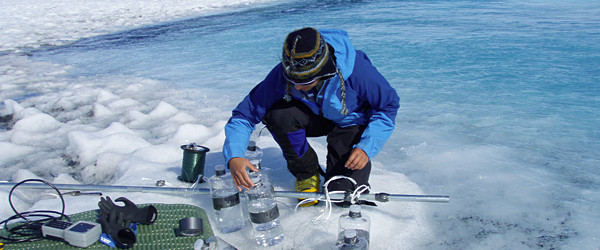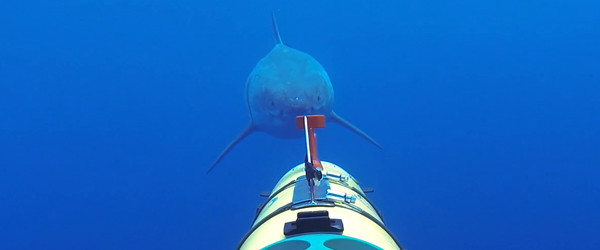Alvin FAQs
SHARE THIS:
What is Alvin and why do we use it?
Alvin is a 3-person research submersible that takes scientists deep into the ocean. Since its launch in 1964, Alvin has taken more than 14,000 scientists, engineers and observers to visit the floor of the deep sea. Alvin can dive as deep as 4,500 m (almost 3 miles), giving it access to some 63% of the entire ocean floor.Alvin is the only deep-diving research submarine that can seat two science observers in addition to the pilot. Visiting the deep ocean in person means the scientists get to see details of the seafloor and its processes with their own eyes. They can also use Alvin’s equipment to sample rocks, sediment, fluids, and sea life.
The sub is named after Allyn Vine, a WHOI engineer and geophysicist who helped pave the way for deep submergence research and technology.
What have we learned using Alvin?
Alvin has made more than 4,700 dives over the last five decades. The submersible has made headlines for locating a misplaced hydrogen bomb in the Mediterranean Sea in 1966, discovering deep-sea hydrothermal vents in the late 1970s, and exploring the sunken ocean liner Titanic in 1986. When not on high-profile assignments such as these, Alvin has been present during literally thousands of discoveries made by scientists on routine research expeditions to the seafloor.See what a deep-diving scientist sees on an Alvin dive with the Framegrabber web tool.
How does it work?
Alvin moves around using seven reversible thrusters: three that move the submersible backward and forward, two for up and down movement, and two for lateral movement/turning. The combination lets Alvin's skilled pilots fly the sub through the rugged topography of the seafloor, hover above it, or come to rest on the bottom.Diving to the sea bottom is done by manipulating Alvin's ballast, rather than by using the thrusters. The pilots start and stop diving by regulating the amount of water and air in the ballast tanks, and by jettisoning expendable steel weights (like sandbags in a hot-air balloon).
Because there is no light in the deep sea, the submersible carries multiple LED lights to illuminate the bottom. Two hydraulic, robotic arms manipulate equipment and collect samples. A sample basket mounted on the front of the submersible can carry up to 400 pounds of equipment including sediment corers, temperature probes, water samplers, biological suction samplers, and insulated storage chambers.
It takes about two hours for Alvin to dive to its maximum depth and another two to return to the surface. That leaves four to six hours for work on the bottom - time that scientists cram full of photography, observations, sampling, and experiments.
» Alvin Interactive Guide
What are Alvin's specifications?
Alvin is 7 m long, 3.7 m tall and 2.6 m wide (23.1 x 12.1 x 8.4 feet), and weighs 20.4 metric tons (45,000 lbs). Full speed ahead is 3.4 km/hr (2 knots), but Alvin usually cruises at 0.8 km/hr (0.5 knot). Dives usually last less than 10 hours, but the sub carries enough oxygen to let a 3-person crew breathe for three days. Operating costs, including support from R/V Atlantis, are about $45,000 per day.The submersible’s cockpit is a titanium sphere 2.1 m (83 inches) inside diameter. The walls are 7.4 cm (2.9 inches) thick, with five viewports: one for the pilot looking forward, and two on each side for the scientists. Supporting the sphere is a frame made of titanium and syntactic foam that provides flotation and houses Alvin’s thrusters, hydraulic controls, electronics and batteries.
» More specifications
» Alvin User Manual
What platforms are needed?
To reach its far-flung study sites, Alvin rides aboard the R/V Atlantis, an 84 m (274-foot) research ship that supplies scientists with multiple onboard labs and state of the art computer facilities and accommodations.Maintaining and operating Alvin takes an at-sea crew of engineers and pilots who are supported on shore by engineering, technical, and logistics staff. Every morning and evening the submersible’s systems are rigorously checked for operational readiness. With such careful attention, Alvin routinely makes 98% of its scheduled dives; missed dives usually happen because of bad weather rather than mechanical failure.
Advantages
When scientists dive in Alvin they get to see directly, with their own eyes, the seafloor terrain, its sea life, and ongoing chemical, biological and geological processes. This is an enormous advantage when trying to make sense of complex interactions between deep-sea animals and their rock or sediment environments. Another important advantage is the ability to bring specific samples of animals, rocks, sediment or fluids from the seafloor back to the surface.Sources
Tim Shank, Director, Ocean Exploration Institute, WHOIRick Chandler, Submersible Operations Administrator, NDSF/WHOI.
Alvin web pages, maintained by NDSF/WHOI










 Facebook
Facebook Twitter
Twitter Instagram
Instagram Vimeo
Vimeo YouTube
YouTube LinkedIn
LinkedIn RSS Feeds
RSS Feeds







